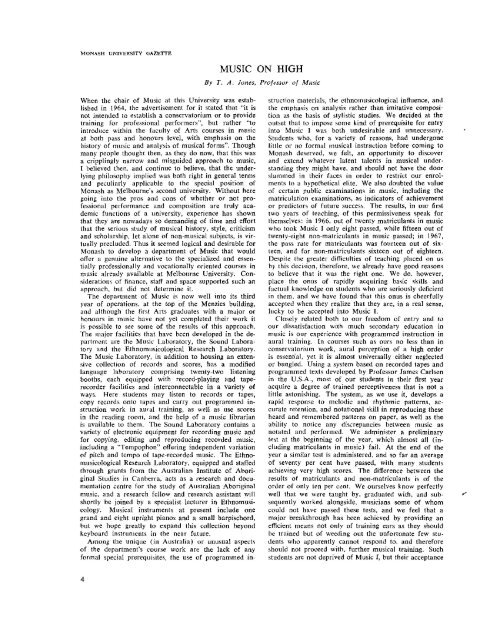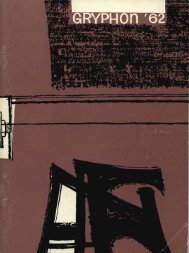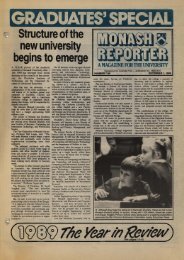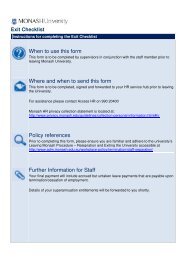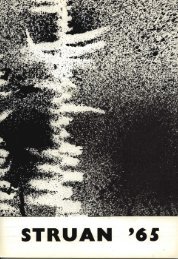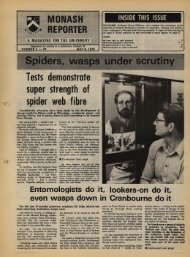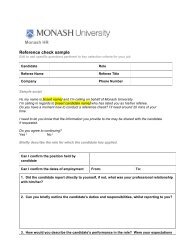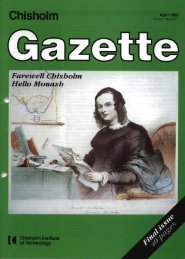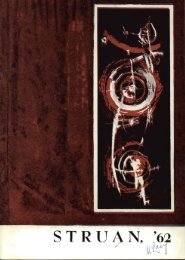GAZETTE - Adm.monash.edu.au - Monash University
GAZETTE - Adm.monash.edu.au - Monash University
GAZETTE - Adm.monash.edu.au - Monash University
- No tags were found...
Create successful ePaper yourself
Turn your PDF publications into a flip-book with our unique Google optimized e-Paper software.
MONASH UNIVERSITY GAZETIEMUSIC ON HIGHBy T. A. Jones, Professor of MusicWhen the chair of Music at this <strong>University</strong> was establishedin 1964, the advertisement for it stated that "it isnot intended to establish a conservatorium or to providetraining for professional performers", but rather "tointroduce within the faculty of Arts courses in musicat both pass and honours level, with emphasis on thehistory of music and analysis of musical forms". Thoughmany people thought then, as they do now, that this wasa cripplingly narrow and misguided approach to music,I believed then, and continue to believe, that the underlyingphilosophy implied was both right in general termsand peculiarly applicable to the special position of<strong>Monash</strong> as Melbourne's second university. Without heregoing into the pros and cons of whether or not professionalperformance and composition are truly academicfunctions of a university, experience has shownthat they are nowadays so demanding of time and effortthat the serious study of musical history, style, criticismand scholarship, let alone of non-musical subjects, is virtuallyprecluded. Thus it seemed logical and desirable for<strong>Monash</strong> to develop a department of Music that wouldoffer a genuine alternative to the specialized and essentiallyprofessionally and vocationally oriented courses inmusic already available at Melbourne <strong>University</strong>. Considerationsof finance, staff and space supported such anapproach, but did not determine it.The department of Music is now well into its thirdyear of operations. at the top of the Menzies building,and although the first Arts graduates with a major orhonours in music have not yet completed their work itis possible to see some of the results of this approach.The major facilities that have been developed in the departmentare the Music Laboratory, the Sound Laboratoryand the Ethnomusicological Research Laboratory.The Music Laboratory, in addition to housing an extensivecollection of records and scores, has a modifiedlanguage laboratory comprising twenty-two listeningbooths, each equipped with record-playing and taperecorderfacilities and interconnectable in a variety ofways. Here students may listen to records or tapes,copy records onto tapes and carry out programmed instructionwork in <strong>au</strong>ral training, as well as use scoresin the reading room, and the help of a music librarianis available to them. The Sound Laboratory contains avariety of electronic equipment for recording music andfor copying, editing and reproducing recorded music,including a "Tempophon" offering independent variationof pitch and tempo of tape-recorded music. The EthnomusicologicalResearch Laboratory, equipped and staffedthrough grants from the Australian Institute of AboriginalStudies in Canberra, acts as a research and documentationcentre for the study of Australian Aboriginalmusic, and a research fellow and research assistant wittshortly be joined by a specialist lecturer in Etbnomusicology.Musical instruments at present include onegrand and eight upright pianos and a small harpischord,but we hope greatly to expand this collection beyondkeyboard instruments in the near future.Among the unique (in Australia) or unusual aspectsof the department's course work are the lack of anyformal special prerequisites, the use of programmed instructionmaterials, the ethnomusicological influence, andthe emphasis on analysis rather than imitative compositionas the basis of stylistic studies. We decided at theoutset that to impose some kind of prerequisite for entryinto Music I was both undesirable and unnecessary.Students who. for a variety of reasons, had undergonelittle or no formal musical instruction before coming to<strong>Monash</strong> deserved, we felt, an opportunity to discoverand extend whatever latent talents in musical understandingthey might have. and should not have the doorslammed in their faces in order to restrict our enrolmentsto a hypothetical elite. We also doubted the valueof certain public examinations in music, including thematriculation examinations, as indicators of achievementor predictors of future success. The results, in our firsttwo years of teaching, of this permissiveness speak forthemselves: in 1966. out of twenty matriculants in musicwho took Music I only eight passed, while fifteen out oftwenty-eight non-matriculants in music passed; in 1967,the pass rate for matriculants was fourteen out of sixteen,and for non-matriculants sixteen out of eighteen.Despite the greater difficulties of teaching placed on usby this decision, therefore, we already have good reasonsto believe that it was the right one. We do, however,place the onus of rapidly acquiring basic skills andfactual knowledge on students who are seriously deficientin them, and we have found that this onus is cheerfullyaccepted when they realize that they are, in a real sense,lucky to be accepted into Music I.Closely related both to our freedom of entry and tvour dissatisfaction with much secondary <strong>edu</strong>cation inmusic is OUf experience with programmed instruction in<strong>au</strong>ral training. In courses such as ours no less than inconservatorium work, <strong>au</strong>ral perception of a high orderis essential, yet it is almost universally either neglectedor bungled. Using a system based on recorded tapes andprogrammed texis developed by Professor James Carlsenin the U.S.A., most of our students in their first yearacquire a degree of trained perceptiveness that is not alittle astonishing. The system, as we use it, develops arapid response to melodic and rhythmic patterns, accurateretention, and notational skill in reproducing theseheard and remembered patterns on paper, as well as theability to notice any discrepancies between music asnotated and performed. We administer a preliminarytest at the beginning of the year, which almost all (includingmatriculants in music) fail. At the end of theyear a similar test is administered, and so far an averageof seventy per cent have passed, with many studentsachieving very high scores. The difference between theresults of matriculants and non-matriculants is of theorder of only ten per cent. We ourselves know perfectlywell that we were t<strong>au</strong>ght by, graduated with, and subsequentlyworked alongside, musicians some of whomcould not have passed these tests, and we feel that amajor breakthrough has been achieved by providing anefficient means not only of training ears as they shouldbe trained but of weeding out the unfortunate few studentswho apparently cannot respond to, and thereforeshould not proceed with, further musical training, Suchstudents are not deprived of Music I, but their acceptance4


